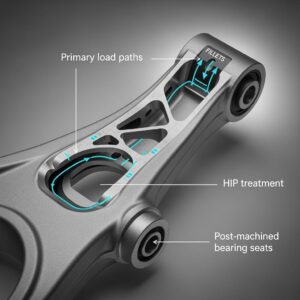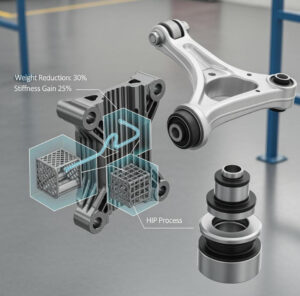Formsprutning av metall
Innehållsförteckning
Översikt över Formsprutning av metall
Metal Injection Molding (MIM) är en transformativ tillverkningsprocess som kombinerar mångsidigheten hos plastformsprutning med styrkan och integriteten hos pulverformig metallurgi. Det möjliggör tillverkning av komplexa metalldelar med hög precision, utmärkt ytfinish och fina detaljer. I huvudsak möjliggör MIM skapandet av metallkomponenter som är för komplicerade eller dyra att producera med traditionella metoder.
Den här artikeln dyker djupt in i metallformsprutningsvärlden och utforskar dess krångligheter, tillämpningar, fördelar och mer. Oavsett om du är en erfaren ingenjör eller en nyfiken nykomling, kommer den här guiden att ge värdefulla insikter om MIM:s anmärkningsvärda kapacitet.
Vad är metallformsprutning?
I kärnan innebär Metal Injection Molding att man blandar fina metallpulver med ett bindemedelsmaterial för att skapa ett råmaterial som sedan sprutas in i en form. Den gjutna delen genomgår en serie avbindnings- och sintringsprocesser för att avlägsna bindemedlet och förtäta metallen, vilket resulterar i en slutprodukt som är nästan 100% tät och uppvisar utmärkta mekaniska egenskaper.

Metallformsprutningsprocessen
MIM-processen består av flera nyckelsteg:
- Förberedelse av råmaterial: Fina metallpulver blandas med ett termoplastiskt bindemedel för att bilda en homogen blandning.
- Formsprutning: Råmaterialet värms upp och injiceras i en form för att bilda den önskade formen.
- Avbindning: Bindemedlet avlägsnas från den gjutna delen, vanligtvis genom en lösningsmedels- eller termisk process.
- Sintring: Den avbundna delen värms upp i en kontrollerad atmosfär för att smälta samman metallpartiklarna, vilket uppnår den slutliga densiteten och styrkan.
Typer av metallpulver som används i MIM
En mängd olika metallpulver kan användas i MIM, som var och en erbjuder unika egenskaper och fördelar. Här är tio specifika metallpulver som vanligtvis används i processen:
- Rostfritt stål 316L: Känd för sin korrosionsbeständighet och höga hållfasthet, vilket gör den idealisk för medicinska tillämpningar och livsmedelsindustrin.
- Rostfritt stål 17-4PH: Erbjuder utmärkta mekaniska egenskaper och kan värmebehandlas för att förbättra hårdhet och styrka.
- Karbonyljärnpulver: Används för sin höga renhet och utmärkta magnetiska egenskaper.
- Nickellegering 718: Ger hög hållfasthet och motståndskraft mot extrema temperaturer och korrosion.
- Titan Ti-6Al-4V: Lätt och biokompatibel, vanligen använd i rymd- och medicinska implantat.
- Koppar C11000: Mycket ledande och används i elektriska och termiska applikationer.
- Inconel 625: Uppvisar utmärkt oxidations- och korrosionsbeständighet, lämplig för högtemperaturapplikationer.
- Molybden TZM: Högtemperaturstyrka och krypmotstånd, används inom flyg- och försvarsindustrin.
- Kobolt-kromlegering: Hög slitstyrka och biokompatibilitet, används ofta i dentala och ortopediska implantat.
- Verktygsstål M2: Hög hårdhet och slitstyrka, idealisk för skärverktyg och stansar.
Egenskaper för vanliga metallpulver
| Metallpulver | Sammansättning | Fastigheter | Tillämpningar |
|---|---|---|---|
| Rostfritt stål 316L | Fe, Cr, Ni, Mo | Korrosionsbeständighet, hög hållfasthet | Medicintekniska produkter, livsmedelsbearbetning |
| Rostfritt stål 17-4PH | Fe, Cr, Ni, Cu | Värmebehandlas, hög hållfasthet | Flyg- och rymdindustrin, fordonsindustrin |
| Karbonyljärnpulver | Rent järn | Hög renhet, magnetiska egenskaper | Elektronik, fordonsindustri |
| Nickellegering 718 | Ni, Cr, Fe, Nb, Mo, Ti, Al | Hög hållfasthet, korrosionsbeständighet | Flyg, olja och gas |
| Titan Ti-6Al-4V | Ti, Al, V | Lätt, biokompatibel | Medicinska implantat, flyg- och rymdindustrin |
| Koppar C11000 | Ren koppar | Hög ledningsförmåga | Elektriska komponenter, termiska system |
| Inconel 625 | Ni, Cr, Mo, Nb | Oxidationsbeständighet, styrka | Tillämpningar för höga temperaturer |
| Molybden TZM | Mo, Ti, Zr | Hållfasthet vid höga temperaturer | Flyg- och rymdindustrin, försvarsindustrin |
| Kobolt-kromlegering | Co, Cr, Mo | Slitstyrka, biokompatibilitet | Tandläkar- och ortopediska implantat |
| Verktygsstål M2 | Fe, Mo, W, Cr, V | Hög hårdhet, slitstyrka | Skärverktyg, matriser |
Tillämpningar av Formsprutning av metall
MIM hittar applikationer inom olika industrier tack vare dess förmåga att producera komplexa och högprecisionsdetaljer. Här är några anmärkningsvärda applikationer:
| Industri | Tillämpningar |
|---|---|
| Flyg- och rymdindustrin | Turbinblad, bränslemunstycken, strukturella komponenter |
| Medicinsk | Kirurgiska instrument, tandimplantat, ortodontiska fästen |
| Fordon | Motorkomponenter, bränsleinsprutare, transmissionsdelar |
| Konsumentelektronik | Kontakter, kylflänsar, komponenter för mobila enheter |
| Försvar | Skjutvapenkomponenter, missildelar, kommunikationsanordningar |
| Industriell utrustning | Kugghjul, ventiler, fästelement, precisionsverktyg |
| Smycken | Klockfodral, spännen, prydnadsdetaljer |
| Energi | Värmeväxlare, borrutrustning, kraftgenereringsdelar |
Specifikationer och standarder för formsprutning av metall
Vid val av metallpulver för MIM beaktas olika specifikationer och standarder för att säkerställa kvalitet och prestanda. Här är en titt på några vanliga standarder:
| Metallpulver | Specifikationer | Standarder |
|---|---|---|
| Rostfritt stål 316L | ASTM A276, ASTM F138 | ISO 5832-1 |
| Rostfritt stål 17-4PH | ASTM A564, AMS 5643 | ISO 15156-3 |
| Karbonyljärnpulver | ASTM A131, ASTM B311 | MIL-I-16923 |
| Nickellegering 718 | ASTM B637, AMS 5662 | ISO 15156-3 |
| Titan Ti-6Al-4V | ASTM B348, ASTM F1472 | ISO 5832-3 |
| Koppar C11000 | ASTM B152, ASTM F68 | ISO 1336 |
| Inconel 625 | ASTM B446, AMS 5666 | ISO 15156-3 |
| Molybden TZM | ASTM B387, ASTM F289 | MIL-M-14075 |
| Kobolt-kromlegering | ASTM F75, ASTM F1537 | ISO 5832-4 |
| Verktygsstål M2 | ASTM A600, AMS 6431 | ISO 4957 |
Fördelar med metallsprutgjutning
Metallformsprutning erbjuder flera betydande fördelar jämfört med traditionella tillverkningsprocesser:
- Komplexa geometrier: MIM kan producera intrikata former som skulle vara svåra eller omöjliga att uppnå med andra metoder.
- Materialeffektivitet: Processen minimerar materialspill, eftersom överskott av råmaterial ofta kan återanvändas.
- Hög precision: MIM-delar tillverkas med snäva toleranser, vilket minskar behovet av sekundär bearbetning.
- Kostnadseffektivt: För stora produktionsserier kan MIM vara mer ekonomiskt än bearbetning eller gjutning.
- Utmärkta mekaniska egenskaper: MIM-delar uppvisar hög hållfasthet, densitet och hållbarhet.
- Brett materialområde: Ett brett spektrum av metallpulver kan användas, vilket ger mångsidighet vid användning.
Nackdelar med metallsprutgjutning
Trots dess fördelar har MIM också några begränsningar:
- Initiala kostnader: Verktyget och beredningen av råmaterial kan vara dyrt för små produktionsserier.
- Begränsningar i storlek: MIM lämpar sig vanligtvis för mindre delar, som vanligtvis väger mindre än 100 gram.
- Avbindningsutmaningar: Avbindningsprocessen kan vara tidskrävande och kräver noggrann kontroll för att undvika defekter.
- Komplexitet i sintring: Att uppnå enhetlig sintring utan förvrängning eller krympning kan vara utmanande.
- Materialrestriktioner: Inte alla metaller är lämpliga för MIM, särskilt de med höga smältpunkter.
Jämförelse av metallformsprutning med andra tillverkningsmetoder
| Parameter | MIM | Maskinbearbetning | Gjutning | Pulvermetallurgi |
|---|---|---|---|---|
| Komplexitet | Hög komplexitet, invecklade former | Begränsad av verktygets tillgänglighet | Måttlig komplexitet | Måttlig komplexitet |
| Materialeffektivitet | Högt, lite avfall | Högt avfall | Måttligt avfall | Lågt avfall |
| Precision | Hög precision, snäva toleranser | Hög precision, men dyr | Lägre precision | Måttlig precision |
| Kostnad för stora körningar | Kostnadseffektivt | Dyrt | Kostnadseffektivt | Kostnadseffektivt |
| Initial verktygskostnad | Hög | Låg till måttlig | Hög | Måttlig |
| Lämplig delstorlek | Liten till medelstor | Vilken storlek som helst | Stor till mycket stor | Liten till medelstor |
| Mekaniska egenskaper | Utmärkt | Utmärkt | Bra | Bra till utmärkt |
Leverantörer och prissättning av metallpulver för MIM
Att hitta rätt leverantör för MIM-pulver är avgörande för att säkerställa kvalitet och kostnadseffektivitet. Här är en titt på några nyckelleverantörer och ungefärliga prisuppgifter:
| Leverantör | Metallpulver | Prissättning (per kg) | Anteckningar |
|---|---|---|---|
| **Sandvik Osprey | Rostfritt stål, nickellegeringar | $50 – $200 | Högkvalitativa pulver, brett utbud |
| Höganäs AB | Järn, rostfritt stål, titan | $30 – $150 | Ledande leverantör, jämn kvalitet |
| Snickeriteknik | Verktygsstål, Titan, Inconel | $100 – $300 | Premiumpulver, omfattande alternativ |
| Avancerade pulverprodukter | Speciallegeringar, rostfria stål | $40 – $180 | Specialiserat på skräddarsydda lösningar |
| Epson Atmix | Fint rostfritt stål, magnetiska pulver | $50 – $220 | Fina pulver med hög renhet |

För- och nackdelar med Formsprutning av metall
Att förstå för- och nackdelarna med MIM hjälper till att fatta välgrundade beslut angående dess implementering:
| Proffs | Nackdelar |
|---|---|
| Producerar komplexa delar med hög precision | Höga initiala verktygs- och råmaterialkostnader |
| Effektiv användning av material | Begränsad till mindre delstorlekar |
| Lämplig för stora produktionsserier | Avbindnings- och sintringsprocesser är känsliga |
| Brett utbud av material tillgängligt | Alla metaller är inte lämpliga för MIM |
| Utmärkta mekaniska egenskaper | Enhetlig sintring kan vara utmanande |
VANLIGA FRÅGOR
| Fråga | Svar |
|---|---|
| Vad är metallinjektionsgjutning (MIM)? | MIM är en tillverkningsprocess som kombinerar metallpulver med ett bindemedel för att skapa invecklade metalldelar. |
| Vilka typer av metaller kan användas i MIM? | Olika metaller inklusive rostfria stål, nickellegeringar, titan och mer. |
| Vilka är fördelarna med MIM? | Hög komplexitet, materialeffektivitet, precision och utmärkta mekaniska egenskaper. |
| Vilka är nackdelarna med MIM? | Höga initiala kostnader, storleksbegränsningar, avbindningsutmaningar och komplexitet vid sintring. |
| Vilka industrier använder MIM-delar? | Flyg, medicin, fordon, hemelektronik, försvar och mer. |
| Hur jämför MIM med andra metoder? | MIM erbjuder högre komplexitet och materialeffektivitet men kan vara dyrare initialt och har storleksbegränsningar. |
| Vilken är den typiska delstorleken för MIM? | Vanligtvis mindre än 100 gram. |
| Finns det några restriktioner för MIM-material? | Ja, metaller med mycket höga smältpunkter eller olämpliga sintringsegenskaper är inte idealiska för MIM. |
| Hur bearbetas MIM-delar efter gjutning? | Delar genomgår avbindning för att avlägsna bindemedlet och sintring för att förtäta metallen. |
| Vad kostar metallpulver för MIM? | Kostnaderna varierar, vanligtvis från $30 till $300 per kilo beroende på metall och leverantör. |
Slutsats
Metallformsprutning är en kraftfull tillverkningsprocess som erbjuder unika fördelar för att producera komplexa metalldelar med hög precision. Genom att förstå dess nyanser, tillämpningar och de olika metallpulver som finns tillgängliga kan tillverkare utnyttja MIM för att uppnå överlägsna resultat på ett kostnadseffektivt sätt. Oavsett om det gäller flyg-, medicin-, fordons- eller andra industrier, fortsätter MIM att tänja på gränserna för vad som är möjligt inom tillverkning av metalldelar.
Dela på
MET3DP Technology Co, LTD är en ledande leverantör av lösningar för additiv tillverkning med huvudkontor i Qingdao, Kina. Vårt företag är specialiserat på 3D-utskriftsutrustning och högpresterande metallpulver för industriella tillämpningar.
Förfrågan för att få bästa pris och anpassad lösning för ditt företag!
Relaterade artiklar

Metal 3D Printing for U.S. Automotive Lightweight Structural Brackets and Suspension Components
Läs mer "Om Met3DP
Senaste uppdateringen
Vår produkt
KONTAKTA OSS
Har du några frågor? Skicka oss meddelande nu! Vi kommer att betjäna din begäran med ett helt team efter att ha fått ditt meddelande.

















